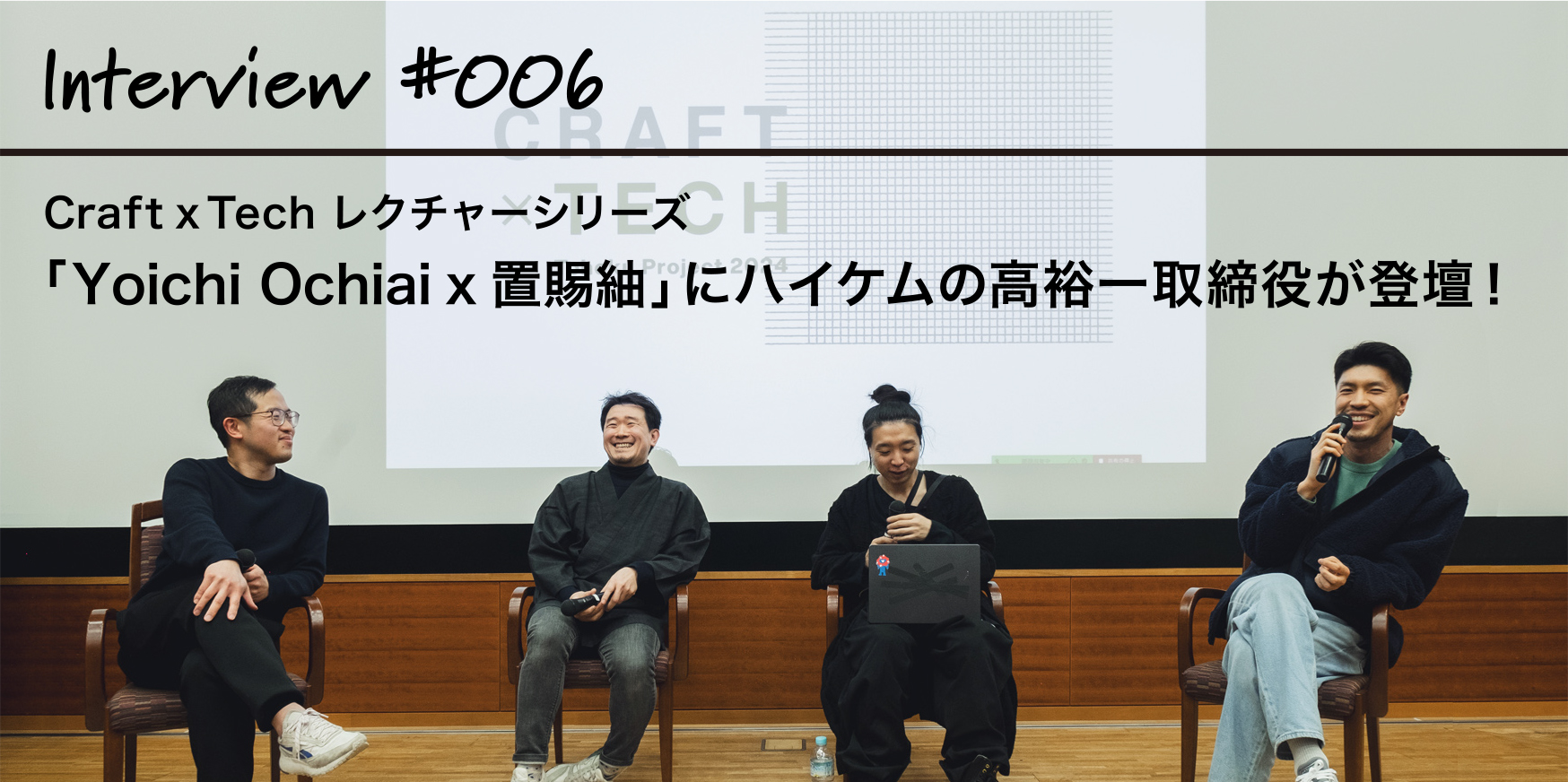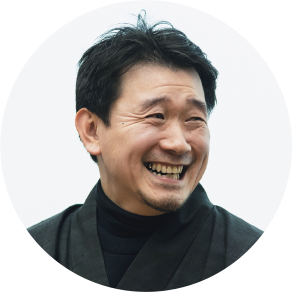
 Photo provided: SHUHEI.W
Photo provided: SHUHEI.W
In this event, under the facilitation of Professor Yoshimoto of the University of Tokyo’s Center for Advanced Science and Technology, a lecture was given by Yoichi Ochiai, who has multiple roles as a researcher, media artist, and entrepreneur, and Gentaro Nitta, the president of Nitta Co., Ltd., who is a maker of the traditional fabric of Yamagata Prefecture, “Oitama Tsumugi”. The lecture allowed us to glimpse the wonderful teamwork of the two, and the content heightened expectations for the synergy that will occur in the future.
Afterwards, Taka also participated in the two’s lecture, and I was allowed to talk a little about the introduction of the company and the future of the textile industry. With Ochiai’s exquisite comments, it was an interesting roundtable discussion. Please read it!
HighChem = A company aiming to develop technology to make fibers from CO2
Could you introduce us to HighChem?
HighChem is a company that my father and mother created.
They are now naturalized, but both of them are Chinese, and they entered a Chinese university as the first generation after the Cultural Revolution ended, started a business in China after graduation, and exchanged their savings for a ticket to Japan. Both of them specialized in chemistry, so they completed the master’s program in chemistry at the University of Tokyo here, then worked as researchers at the current Mitsubishi Chemical (formerly Mitsubishi Oil Chemical), and about 25 years ago, they started HighChem as a specialty trading company in chemistry as a couple.
My father’s specialty is a field called C1 Chemical, and he is a person who is diligently researching how to convert carbon into substances. Among them, HighChem’s most characteristic technology is manufacturing the raw material of polyester from CO (carbon monoxide), but recently, as the world is demanding carbon neutrality and greening, we want to develop technology to change this CO (carbon monoxide) to CO2 (carbon dioxide). In other words, we are a company aiming to manufacture polyester, which is the raw material for fibers, from CO2.
It’s amazing. When I first heard Taka’s story, I was really surprised that a story like alchemy, such as making fibers from CO2, was almost proven and close to practical use.

In order to realize this alchemy, a new technology is needed to change CO to CO2. This technology is currently under development and in the demonstration stage, and could be put into practical use at any time. However, introducing that process will cause the cost to skyrocket, and the price of polyester will be about 10 times higher. The chemical industry is a huge equipment industry with a slim margin, so it is a little difficult to put it into practical use in a state where customers do not commit.
So, I think it’s interesting to collaborate with companies that can add value to products, such as high brands and sports brands. If this initiative goes well, the day may be near when clothes made from CO2 will normally enter your life.
Adding Value with Meaningful CO2
I can feel the future of textiles.
Mr. Ochiai, have you heard such a story?

Are you talking about carbon recycling? There might be quite a few in the textile sector.
However, the cost issue is quite significant.
Since I’m a photographer, when I print photos, I make them at hot springs or with Dead Sea salt, but what kind of CO2 I use becomes quite the issue.
What do you mean?

If you did it at a crematorium, you might be able to get interesting CO2 (laughs).
Because it’s a space with significance. It’s carbon neutral.

This space is about 400ppm, so even if you try hard to collect it, you may or may not be able to make one thread. In other words, it is more efficient to collect things from places with high CO2 concentration, such as factory exhaust gas, to make CO2 a raw material. However, as Mr. Ochiai says, there are needs for people who want to sell things in a sustainable context to use CO2 with a clean image.

Like the exhaust gas emitted by Ayrton Senna.
The significance is interesting, isn’t it?
I think apparel has a lot of potential for Japan’s chemical industry. The chemical industry is a reaction industry, and it’s in the middle of the river. Most chemicals are made from oil. The raw material cost is determined by the oil company, and the outlet is determined by people who make apparel and household goods. The chemical company itself doesn’t have much opportunity to add value and pass it on to customers. However, if we can develop a technology to make fibers from air, we can sell directly to outlets like apparel as an upstream existence. I think that’s when the significance of CO2 comes to life.

Even though they’re all CO2 (laughs).
Even though it’s supposed to be the same CO2, the significance of CO2 is different, so this CO2 is safer, and if other animals hear it, it’s quite a surprising story.
Poly Lactic Acid (PLA) Fiber Successfully Developed with the Technical Skills of Traditional Crafts

I would like to introduce you to the jacket I am wearing, which is 100% made from plant starch. This itself is made by fermenting corn starch once to make lactic acid. This lactic acid is polymerized to create a material called Polylactic Acid (PLA).
You may have heard of sustainable materials in the bio sector, such as vegan leather.
However, compared to such things, corn has a great advantage in that it is produced on a large scale worldwide. To be sustainable, it must always be incorporated into daily life, and the price must become affordable.
On the other hand, there was a big challenge with Polylactic Acid (PLA). Because it is made from corn starch, it is weak when heated. Fibers are dyed at high temperatures, so if you try to dye them at the same temperature range as polyester, they will not take color and will fall apart. When I was wondering what to do, I asked traditional Japanese weavers and dyers, and they dyed it beautifully.
This is probably a story about the indescribable power that traditional Japanese crafts have, and about ethnicity. Probably other countries can’t do the same thing. Japanese traditional crafts have a mindset of “I’ll do it until I can,” which is definitely different from other countries. Looking back, I think there are points where our company is connected to Craft Tech’s efforts.
I see, that’s really true.
Mr. Nitta, do you also have collaborations with people in the industrial textile industry?

Our company basically deals with silk materials, but because Yonezawa has been actively conducting research on textiles since the Edo period, we always want to take on new challenges. For example, I am interested in trying various things other than silk, such as rayon and polyester, and creating new things.
The basic is silk, but trying various things and creating new things. I think that ultimately leads to knowing myself.

This could be an opportunity for a collaboration with HighChem.
This kind of collaboration is what this Craft Tech project aims for.

(From left)
Hideki Yoshimoto
Special Associate Professor of Advanced Art Design at the University of Tokyo’s Center for Advanced Science and Technology. Founder of design studio TANGENT. He presents various works by integrating design and technology, and provides many designs to global brands. He is the initiator and general producer of “Craft x Tech”, and is also one of the participating creators.
Gentaro Nitta
Born in 1980 in Yonezawa City, Yamagata Prefecture. In 2003, he studied kimono and weaving at a long-established obi shop in Kyoto. Joined Nitta Co., Ltd. in 2005. He has won numerous awards, including the “Newcomer Award” at the Japan Traditional Crafts Exhibition, the “Association Award” from the Yonezawa City Art and Culture Association, the “Newcomer Award” at the MOA Okada Mokichi Award, and the “Tokyo Metropolitan Board of Education Award” at the Japan Crafts and Textile Exhibition. He was the representative of Yamagata Prefecture for the LEXUS NEWTAKUMI PROJECT 2017. In 2017, he became the President (5th generation) of Nitta Co., Ltd. He is a regular member of the Japan Crafts Association.
Yoichi Ochiai
Media artist. Born in 1987, he started his artistic activities around 2010. He develops works with motifs of materialization and conversion in boundary areas, and longing for mass. Associate Professor at Tsukuba University, Special Professor at Digital Hollywood University. Theme Business Producer for the 2025 Japan International Exposition (Osaka/Kansai Expo).
In recent years, he has held numerous exhibitions, including “Childhood to You (Tokyo Museum of Contemporary Art, 2020)”, “Kitakyushu Future Creation Art Festival ART for SDGs (Kitakyushu, 2021)”, “Ars Electronica (Austria, 2021)”, “Study: Osaka Kansai International Art Festival (Osaka, 2022)”, “Ubiquitous Body, Intersecting Time and Space (Kusakabe Folk Art Museum, 2022)”, etc. He also directs various collaborations, such as the “Yoichi Ochiai x Japan Phil Project”.
Yuichi Taka
Born in 1986. After graduating from Fudan University in China, he joined Ube Industries (now UBE) and then HighChem in 2014. In January 2022, he became a director and head of the Sustainnovation Division at HighChem Co., Ltd.
About Craft x Tech
https://www.craft-x-tech.com/
This is a new initiative promoted by the University of Tokyo’s Center for Advanced Science and Technology and others, connecting traditional Japanese crafts with contemporary technology. By producing collaborations between traditional craft regions and globally active designers and artists, it aims to bring new discoveries to crafts that sometimes have hundreds of years of history. The first Craft x Tech 2023 has realized collaborations between 6 production areas in 6 prefectures in Tohoku and 6 creators.



